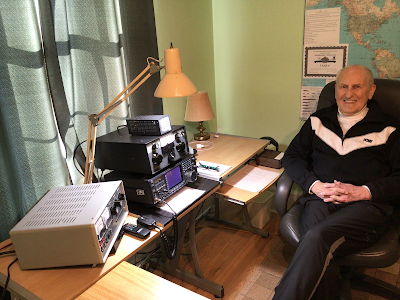I have made 11 contacts using the SolderSmoke Direct Conversion receiver. Ten of the 11 were after June 3, 2025. This was in very casual operation, operating with less than 1 watt with a dipole antenna.
1. The first of course was back in February 2023 with W4AMV. On this one I was using a simple "10 Minute Transmitter" that I threw together thinking that I would use it to demonstrate the receiver to our high school students. "Wait a minute," I thought. I called CQ and W4AMV answered. I was running about 100 mW. He too was using homebrew gear. https://soldersmoke.blogspot.com/2023/02/first-qso-with-high-school-receiver-100.html
2, 3, 4. On June 4, 2025 I again fired up the 10 minute transmitter. My T/R scheme was VERY simple: I have an MFJ coax switch that I use to select the rigs that will connect to my various antennas. On the antenna switch I selected my 40 meter dipole. I ran two pieces of coax from two different positions on the MFJ switch. One I marked RX, the other TX. The transmitter and the receiver were working off 9 volt batteries. I quickly worked N2WJW. Gil in New Jersey. But I noticed that the 10 Minute rig was drifting. So I pulled out my trusty old Tuna Tin 2 transmitter and used it to heartlessly replace the 10 Minute Transmitter. Now with SEVERAL HUNDRED milliwatts, I worked W2XS, John in New York on June 5, 2025. Later that same day I worked N9FGC in Indiana.
5. My most amazing contact came on June 7, 2025. Here is my log entry: 40CW K1OA First 2 way contact with station also using a SolderSmoke DC Receiver!At around 0630 EDT on June 7, 2025 I heard K1OA calling CQ on 7030 kHz CW. This was exactly where I had a crystal. I called him, but he didn't hear me. I sent him an e-mail. We tried again -- he heard me calling him and I heard him responding by calling me, but I don't think we succeeded in exchanging signal reports. It was close, but no cigar. I had to walk the dog. Scott and I agreed to meet on 7030 kHz at 0730 EDT. Arggh. There was a QSO there. I thought we might have to try to change frequency, but this would have been tough because both of us were crystal controlled on transmit. Fortunately, the contact on 7030 kHz wrapped up. Scott called me, I responded, and we were able to exchange signal reports. I was so excited that I almost forgot to hit the record button on my phone. But I caught the last minute or so.This was really something. This really goes to prove what Dean and I have been saying all along: this receiver is not a toy! It can be used for real ham radio contacts. And now we have had these receivers on both ends of a contact. For transmit, Scott was using a KA4KXX transmitter with about 3 watts output. I was on my Tuna Tin 2 at about half a watt output.
6, 7, 8. Later on June 7, 2025 I worked an old friend, Jim W1PID. Jim is a friend of Homebrew Hero Mike AA1TJ, and was involved in Mike's effort to cross the Atlantic with a voice-powered rig. Jim also was one of my contacts with the ET-2 QRPppp rig. I also worked WZ2J Vin in NJ. I also worked John W2XS again.
9. June 11, 2025 (Really evening of 10 June 2025) Famous homebrewer, Anchorologist, Heatkit authority and fellow member of the QRP Hall of Fame Mike Bryce called me! 40CW 0034 WB8VGE Mike Bryce came back to my CQ! Mike wrote: Nothing like quartz locked frequency control!You know it sounded pretty damn good at 500mW. You were holding your own until QSB would take you out in a deep fade. But all in all, one hell of great QRP QSO.I was running my Ten Tec Scout that I had just put back together a couple of days ago. Got around to putting the case back on it tonight, and had it cooking in the back ground just listening to the stations come and go. I had worked a few POTA stations near by and found a quite spot. I was working on a project when I heard your CQ through the din of the 40M band. Glad I took a break and worked your QRPp signalbest 73 QRP # 4816 You get a QSL for that QSO!
Here's my post about Mike, WB8VGE: https://soldersmoke.blogspot.com/2018/09/wb8vge-on-qso-today-qrp-hb-boatanchors.html
10. Around June 11, 2025 I worked W4MY in a contest.
11. On June 12, 2925 I worked some DX with the rig. It was VA3ICC, Ian in Ontario.





































